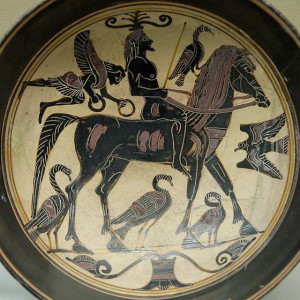Is Groundhog Day Modern Augury? Posted by Brittany Britanniae on Feb 5, 2015 in Roman culture
Salvete Omnes,
Earlier this week, Groundhog Day was celebrated on February 2. According to folklore, if the groundhog sees it shadow and retreats back to its burrow then there will be six more weeks of winter. However, if it is cloudy when a groundhog emerges, then perhaps spring will come early. Modern customs of the holiday involve celebrations where early morning festivals are held to watch the groundhog emerging from its burrow.
The first documented American reference to Groundhog Day can be found in a diary entry from February 4, 1841.
Last Tuesday, the 2nd, was Candlemas day, the day on which, according to the Germans, the Groundhog peeps out of his winter quarters and if he sees his shadow he pops back for another six weeks nap, but if the day be cloudy he remains out, as the weather is to be moderate.
Candlemas is thought to be taken from the Pagan holiday Imbloc, which falls on the halfway point of the winter solstice and spring equinox. Thus, Groundhog Day is a seasonal celebration from its historic roots.
The Groundhog holiday is one deep within American folklore and tradition. I, personally, find it extremely reminiscent of antiquity and augury. The use of animals in predicting or interpreting omens. The groundhog is used to “predict” when winter or spring will arrive, but ultimately the groundhog’s decision is the determining factor. Augury was the practice in Roman religion of interpreting the message or omen from the flight of birds.

A confident rider, surrounded by birds of good omen is approached by a Nike bearing victor’s wreaths on this Laconian black-figured kylix, ca. 550–530 BCE. Courtesy of WikiCommons.
Unlike modern times, where animals and superstitions (such as the groundhog and weather, black cats and bad luck, rabbit’s foot and good luck, etc.) are closer to traditions; the idea of augury was not only a tradition, but a way of life. Augury influenced important decisions like war, festivals, appropriate sacrifices to the gods, and divine favor for politicians.
Politics and Augury
In Ancient Rome, it was through birds and their flight that Jupiter’s will was interpreted. Auspices (the interpretation of the augury) showed Romans what they were to do, or not to do; giving no explanation for the decision made except that it was the will of the Gods. It would be difficult to execute any public act without consulting the auspices. These auspices or augury were interpreted by priests of Jupiter Optimus Maximus. The following video (purposefully started at 6:28 and ending around 8:03) talks a bit about augury and Rome within HBO’s series Rome:
Types of Auspices:
- 1. ex caelo [meaning from the sky]: This auspice involved the observation of thunder and lightning. This was thought of being the most important auspice to observe. For this was seen as the most direct way of Jupiter communicating with priests and priestesses.
- 2. ex avibus [meaning from birds]: Albeit, auspices were typically bird signs, not all birds in the sky were seen as symbols of the will of the Gods. There were two classes of birds: Oscines and Alites. The former gave auspices via their singing; and the latter, who gave auspices via how they flew. The Oscines included ravens, crows, owls and hens. The birds of the Alites were the eagle, the vulture.
- 3.ex tripudiis [meaning from the “dance” (of birds feeding)] These auspices were read by interpreting the eating patterns of chickens and were generally used on military expeditions.
So, that concludes my comparison between the tradition of Groundhog Day and ancient Roman augury. I hope you enjoyed!

Build vocabulary, practice pronunciation, and more with Transparent Language Online. Available anytime, anywhere, on any device.
About the Author: Brittany Britanniae
Hello There! Please feel free to ask me anything about Latin Grammar, Syntax, or the Ancient World.





